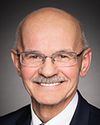Thank you for the question.
I want to reiterate how important hunters are. These are people who are on the land and who know what's normal. In any kind of disease situation, unless you know what's normal, you can't detect the abnormal, so that integration, that co-operation with hunters and indigenous people and whoever else is on the land, is critical to what we do.
We at the Canadian Wildlife Health Cooperative put a ton of effort into education for that very reason. For example, we're working with the Government of British Columbia right now to revise a very popular manual called “Diseases You Can Get From Wildlife”, which goes through in great detail the types of diseases and how to avoid getting those. We're doing a refresh on that document right now.
Our website, for example, is full of material intended for people exactly like hunters, who are on the ground and who can tell us when something is different, such as whether a lesion is something they've never seen before. They often have decades of experience butchering animals. When they say, “Hey, this is something weird,” and they call us, send us an email or use our online reporting app or even the mobile app that we're developing right now for reporting, that first notification is crucial for us to be able to see what's going on on the ground. At the end of the day, there are very few of us in our labs in Saskatoon, Guelph or Saint-Hyacinthe, so we need that co-operation with people who are on the land.




